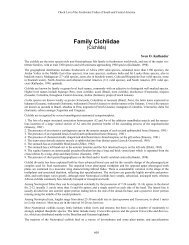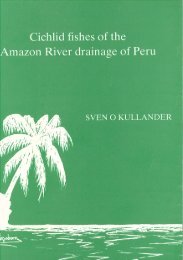Open Access PDF - Sven Kullander
Open Access PDF - Sven Kullander
Open Access PDF - Sven Kullander
You also want an ePaper? Increase the reach of your titles
YUMPU automatically turns print PDFs into web optimized ePapers that Google loves.
338<br />
Fig. 40. Cichla mirianae, paratype, NRM 46003, adult male, 303 mm SL; Brazil: Mato Grosso: Rio Juruena at ferry<br />
crossing, 60 km E of Juína (right side, reversed).<br />
Fig. 41. Cichla mirianae, paratype, NRM 46003, adult female, 207 mm SL; Brazil: Mato Grosso: Rio Juruena at<br />
ferry crossing, 60 km E of Juína.<br />
spots on head, flank or dorsum. Probable female<br />
152 mm SL retains white spots on nape, dorsum<br />
and side. Black spots on gill cover. Lateral band<br />
indistinct, faded on posterior part of caudal peduncle,<br />
and in transition to rows of dark spots of<br />
larger specimens. Female 315 mm SL similar, with<br />
small light spots scattered on side and densely<br />
on side of head, but only limited faint brownish<br />
markings representing the horizontal band.<br />
Holotype, 236 mm SL (MZUSP 92399, Fig. 42),<br />
light brown on dorsum, with small light spots on<br />
dorsal side. Spinous dorsal fin brownish with<br />
about three rows of light spots on spinous portion,<br />
five rows on soft portion, Anterior two lateral<br />
blotches dark brown, posterior blotch black, connected<br />
by smaller irregular dark brown blotches<br />
in narrow band continued short distance posterior<br />
to posterior black blotch; all dark markings<br />
margined with dull whitish or silvery spots.<br />
Otherwise similar to 207 mm SL female.<br />
Live colouration. Male, NRM 46003, freshly<br />
captured, olivaceous to yellowish on lower part<br />
of head and lower flanks.<br />
Geographical distribution. Known from the<br />
upper Rio Tapajós drainage, in the Juruena and<br />
Teles Pires rivers, and from the middle and upper<br />
Rio Xingu drainage, in the Fresco, Batovi, Culuene<br />
and Suiá-Missu rivers (Fig. 9).<br />
Lowe-McConnell (1991), reported Cichla ‘xingu’<br />
as abundant in the Rio Suiá-Missu, and<br />
present in Suiá-Missu lakes, and observed in the<br />
Córrego do Gato (also a tributary of the Rio Suiá-<br />
Missu). The only specimen preserved, however,<br />
comes from the Córrego do Gato. Other records<br />
<strong>Kullander</strong> & Ferreira: Review of Cichla




